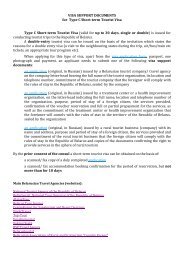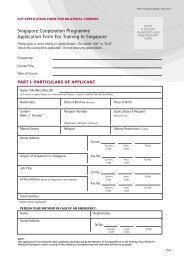BOX 2.6Final assembly is about more than low wagesThe iPhone and iPad, two popular technology products, are assembled in afirm in Shenzen, China, and sold worldwide at retail prices in the hundredsof dollars. The value of labour performed in China, at under $10, accountsfor less than 2% of the cost of an iPad, while just 3.6% of the wholesalecost of an iPhone went to Chinese workers. The rest of the value is earnedby suppliers of parts and components headquartered in Germany, Japan,the Republic of Korea and the United States. Korean firms LG and Samsungmake the display and memory chips; Apple retains the product design, softwaredevelopment and marketing functions in the United States; and theassembly firm is owned by a company from Taiwan Province of China.The low share of value captured by workers in China could give theimpression that assembly does not require much sophistication. This ismisleading. While Asia is attractive because of cheaper wages, especiallyfor semiskilled workers, a more important challenge for technologycompanies is managing global supply chains that involve procuring partsand components from hundreds of companies. This requires a rare combinationof industrial skills, flexibility, speed and diligence at both the individualand collective levels. For instance, an Apple executive told TheNew York Times that “the US has stopped producing people with the skillswe need.”Consider this incident from mid-2007, when Apple hastily redesignedthe glass for the iPhone’s screen. The first delivery of a new load of strengthened,scratch-free glass arrived at a Foxconn plant in the middle of the night,and work started immediately. Within three months, Apple had sold a millioniPhones. It took 15 days to hire 8,700 industrial engineers to overseethe 200,000 assembly-line workers eventually involved in manufacturingiPhones. Apple’s internal estimate was that a similar feat in the UnitedStates would have taken nine months.Source: HDRO; Kraemer, Linden and Dedrick 2011; Xing and Detert 2010; Duhigg and Bradsher 2012.countries have even resorted to unique creditarrangements to fund infrastructure, backed bysupplies of commodities. 53Neither the complementary nor the competitiveperspective is sufficient to explainSouth–South interactions. Because a competitiverole today may easily turn into acomplementary role tomorrow, these labelsshould not be applied rigidly. Moving fromcompetition to cooperation seems to dependon policies for dealing with new challenges.More pessimistic pronouncements thatthere is no hope for industrialization inSub-Saharan Africa have been overtaken byrealities on the ground, which demonstrate anability to advance despite or maybe because ofcompetition. In this regard, African writerssuch as Dambisa Moyo are positive about themutually beneficial role of new actors in thecontinent. 54The shift from traditional to emerging marketsis also affecting countries in ways that aredifficult to predict. Take the timber industry inAfrica, which has reoriented itself from servinga predominantly European market towardsChina. 55 In sheer volume China is the mostimportant market, which is good for focusingbusiness on it. The set of technical standardsthat China requires of exporters, however, isless onerous than those the European Unionrequires. Standards range from product specificationsto accreditation from third-partycertification schemes for forest sustainabilityand health regulations governing formaldehydeemissions. There is no evidence so farthat the shift towards emerging markets isbeing accompanied by a ratcheting up of thetechnical standards they require, which wouldhave required upgrading workers’ skills andcapabilities. 56Innovation and entrepreneurshipin the SouthIn North–South trade, the newly industrializingeconomies developed capabilities forefficiently manufacturing complex productsfor developed country markets. But South–South interactions have enabled companiesin the South to adapt and innovate in waysthat are more suited to developing countries.This includes new business models wherebycompanies develop products for a large numberof low-income customers, often with lowmargins.Countries of the South are also naturallocations for experimentation in new technologiesand products, such as those basedon the global system for mobile (GSM) communicationsstandard. Under the 2005 GSMEmerging Markets Initiative, manufacturersslashed the price of mobile handsets by morethan half and expanded the GSM subscriber54 | HUMAN DEVELOPMENT REPORT <strong>2013</strong>
ase by 100 million connections a year. Thisin turn stimulated investment: in 2007, mobileoperators, including South Africa’s MTNand Kuwait’s Zain, announced a five-yearplan to invest an additional $50 billion inSub-Saharan Africa to improve mobile coverageand expand it to 90% of the population.Indeed, the spectacular increase in phoneconnectivity in Africa has been driven almostentirely by companies based in India, SouthAfrica and the United Arab Emirates. 57Mobile phone manufacturers have alsore-engineered products for the needs of lowerincome consumers. For example, in 2004, TIIndia, a research and development centre ofTexas Instruments in Bengaluru, designed asingle-chip prototype for use in high-quality,low-cost mobile phones. In 2005, Nokia, in cooperationwith TI, began to market the Indianmadeone-chip handsets in India and Africa,selling more than 20 million units. Single-chipdesigns have also emerged for other devices,including affordable digital display monitorsand medical ultrasound machines. Intel hasdeveloped a handheld device for rural banking,and Wipro has marketed a low-power desktopcomputer for basic Internet connectivity. Andin 2008, Tata announced the ultra-low-costNano car, exportable in kits for assembly bylocal technicians.Technology diffusion through South–South investment is also unleashing entrepreneurialspirit, particularly in Africa. Peopleare often self-organizing, creating buyer–sellerrelationships and becoming entrepreneurs tofill unmet needs in spontaneously sproutingmarkets. This is evident in the uses to whichAfricans are putting affordable Asian-builtmobile phones: cellular banking, for example,is cheaper and easier than opening a bankaccount; farmers can obtain weather reportsand check produce prices; and entrepreneurscan provide business services through mobilephone kiosks. The use of mobile phones inNiger has improved the performance of thegrain market, and Ugandan farmers are usingmobile phones to obtain higher prices fortheir bananas.These and other transformations multiplythe possibilities of what people can do withtechnology: participating in decisions thataffect their lives; gaining quick and low-costaccess to knowledge; producing cheaper, oftengeneric medicines, better seeds and new cropvarieties; and generating new employment andexport opportunities. These possibilities cutacross income classes, reaching down to thegrassroots.To respond to the changing needs of middleclass consumers, companies doing well in theSouth tend to be long-term risk-takers andagile in adapting and innovating products forlocal buyers. Consumers in the South tend tobe younger, are often first-time shoppers formodern appliances with distinct in-store habitsand are usually more receptive to branding.Companies in emerging market economieshave the advantage of different managementapproaches from those dominant in the North:majority shareholders have greater power andredeploy resources more speedily than those incompanies in the North. 58Some of these developments are based oninteractions among research and developmentinstitutions, businesses and communitystakeholders. In such ways, innovation and itsbenefits spread, spawning faster change. Thereis greater appreciation of a broader role for thestate in stimulating research and developmentand in nurturing synergies stemming fromcooperation among private, university andpublic research institutions. For example, manyAfrican countries have emulated the early successof Mauritius in attracting East Asian FDIby creating export processing zones. Malaysia’sinvestment promotion policies have also beenwidely copied.Increasingly, the most important engine ofgrowth for countries of the South is likely tobe their domestic market. The middle class isgrowing in size and income. By 2030, 80% ofthe world’s middle class is projected to live inthe South. Countries in South Asia and EastAsia and the Pacific will alone account for 60%of the middle class population and 45% of totalconsumption expenditure. 59 Another estimateis that by 2025, a majority of the 1 billionhouseholds earning more than $20,000 a yearwill live in the South. 60Since 2008, Chinese, Indian and Turkishapparel firms have shifted production fromshrinking global markets to expanding domesticmarkets. Greater reliance on domesticmarkets will boost internal dynamism andCompanies doing well inthe South tend to be longtermrisk-takers and agilein adapting and innovatingproducts for local buyersChapter 2 A more global South | 55
- Page 1 and 2:
WNSEHuman DevelopmentReport 2013The
- Page 3 and 4:
Human Development Report 2013The Ri
- Page 5 and 6:
Human Development Report 2013 TeamD
- Page 7 and 8:
Finally, the Report also calls for
- Page 9 and 10:
Heather Simpson, Ben Slay, Mounir T
- Page 11 and 12:
3.6 India’s Supreme Court issues
- Page 13 and 14:
OverviewOne of the most heartening
- Page 15 and 16: and sustainability are fully incorp
- Page 17 and 18: Without investment in people, retur
- Page 19 and 20: opportunity to reap the full benefi
- Page 21 and 22: Woods institutions, the United Nati
- Page 23 and 24: IntroductionWhen developed economie
- Page 25 and 26: leading economies—Brazil, China a
- Page 27 and 28: comparable access to information, e
- Page 29 and 30: mobile phones: cellular banking is
- Page 32 and 33: “The political problem ofmankind
- Page 34 and 35: BOX 1.1Fairness, macroeconomics and
- Page 36 and 37: BOX 1.3Amartya Sen, Nobel Laureate
- Page 38 and 39: FIGURE 1.1Income per capita is risi
- Page 40 and 41: BOX 1.4Subjective indicators of wel
- Page 42 and 43: FIGURE 1.4There is notable variatio
- Page 44 and 45: FIGURE 1.6Most regions show declini
- Page 46 and 47: Progress in humandevelopment achiev
- Page 48 and 49: BOX 1.7Social competencies: human d
- Page 50 and 51: TABLE 1.3Inequality and satisfactio
- Page 52 and 53: Not all countries havethe precondit
- Page 54 and 55: “When the music changes,so does t
- Page 56 and 57: BOX 2.1The South’s integration wi
- Page 58 and 59: FIGURE 2.1As a share of world merch
- Page 60 and 61: BOX 2.2Acquisitions by the South of
- Page 62 and 63: FIGURE 2.3Between 2000 and 2010, In
- Page 64 and 65: FIGURE 2.4Export earnings per capit
- Page 68 and 69: Instead of having a centreof indust
- Page 70 and 71: FIGURE 2.6Emerging market economies
- Page 72 and 73: Developing countriestrade more amon
- Page 74 and 75: “We cannot expect thatall nations
- Page 76 and 77: TABLE 3.1Selected developing countr
- Page 78 and 79: A common featureof countries thatha
- Page 80 and 81: More important thangetting prices r
- Page 82 and 83: BOX 3.5Eastern Europe and Central A
- Page 84 and 85: States have to beconscious that the
- Page 86 and 87: As countries develop,they tend to d
- Page 88 and 89: Having weathered theAsian financial
- Page 90 and 91: Providing publicservices that contr
- Page 92 and 93: Advancing health requiresmore than
- Page 94 and 95: Universal public healthand educatio
- Page 96 and 97: • China. The Minimum Livelihood G
- Page 98 and 99: “Each generation will reap whatth
- Page 100 and 101: concerns will make for a complex en
- Page 102 and 103: A greater emphasison education cans
- Page 104 and 105: FIGURE 4.1Under the fast track scen
- Page 106 and 107: Around the worldpeople are calling
- Page 108 and 109: FIGURE 4.4Different environmental s
- Page 110 and 111: FIGURE 4.5Education policies can al
- Page 112 and 113: BOX 4.2China and Ghana: who benefit
- Page 114 and 115: FIGURE 4.8countries thus converge t
- Page 116 and 117:
“Let us join hands to try tocreat
- Page 118 and 119:
Areas of globalinternational concer
- Page 120 and 121:
Addressing climatechange requires t
- Page 122 and 123:
International governanceis increasi
- Page 124 and 125:
BOX 5.2Jo Leinen, Member of the Eur
- Page 126 and 127:
facilitates reserve investments and
- Page 128 and 129:
Responsible sovereigntytakes the lo
- Page 130 and 131:
FIGURE 5.1Under the accelerated pro
- Page 132 and 133:
Good policymakingrequires greater f
- Page 134 and 135:
A fair and less unequalworld requir
- Page 137 and 138:
NotesOverview1 Atsmon and others 20
- Page 139 and 140:
25 Blinder 2006.26 UNIDO 2009.27 UN
- Page 141 and 142:
which is 61.7 deaths per 1,000 live
- Page 143 and 144:
ReferencesAbdurazakov, A., A. Minsa
- Page 145 and 146:
urban_world_cities_and_the_rise_of_
- Page 147 and 148:
Kamau, P., D. McCormick, and N. Pin
- Page 149 and 150:
Labor Administration. Geneva: Inter
- Page 151 and 152:
Human Development Report 2013The Ri
- Page 153 and 154:
Statistical acknowledgementsThe Rep
- Page 155 and 156:
Key to HDI countries and ranks, 201
- Page 157 and 158:
Human Development Report 2013The Ri
- Page 159 and 160:
Human Development Report 2013The Ri
- Page 161 and 162:
Human Development Report 2013The Ri
- Page 163 and 164:
Human Development Report 2013The Ri
- Page 165 and 166:
Human Development Report 2013The Ri
- Page 167 and 168:
Human Development Report 2013The Ri
- Page 169 and 170:
Human Development Report 2013The Ri
- Page 171 and 172:
Human Development Report 2013The Ri
- Page 173 and 174:
Human Development Report 2013The Ri
- Page 175 and 176:
Human Development Report 2013The Ri
- Page 177 and 178:
Human Development Report 2013The Ri
- Page 179 and 180:
Human Development Report 2013The Ri
- Page 181 and 182:
Human Development Report 2013The Ri
- Page 183 and 184:
Human Development Report 2013The Ri
- Page 185 and 186:
Human Development Report 2013The Ri
- Page 187 and 188:
Human Development Report 2013The Ri
- Page 189 and 190:
Human Development Report 2013The Ri
- Page 191 and 192:
Human Development Report 2013The Ri
- Page 193 and 194:
Human Development Report 2013The Ri
- Page 195 and 196:
Human Development Report 2013The Ri
- Page 197 and 198:
Human Development Report 2013The Ri
- Page 199 and 200:
Human Development Report 2013The Ri
- Page 201 and 202:
Human Development Report 2013The Ri
- Page 203 and 204:
Human Development Report 2013The Ri
- Page 205 and 206:
Human Development Report 2013The Ri
- Page 207 and 208:
Human Development Report 2013The Ri
- Page 209 and 210:
Human Development Report 2013The Ri
- Page 211 and 212:
Statistical referencesADB (Asian De
- Page 213 and 214:
Core features of the model pertinen
- Page 215 and 216:
Countries and HDI ranks in 2012 and
















